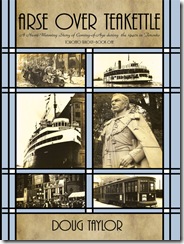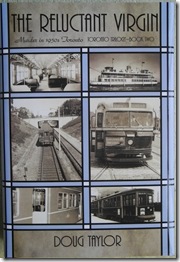The second book in the “Toronto Trilogy” is now available at Chapters/Indigo at book stores. Entitled “The Reluctant Virgin,” it continues where the first book in the trilogy, “Arse Over Teakettle,” ended.
Below is a summary of the three books of the trilogy.
“Arse Over Teakettle” – Book One of the Toronto Trilogy
The first book in “The Toronto Trilogy”is a heart-warming tale containing vivid descriptions of the the city as the Great Depression ends. The reader experiences the city through the eyes of a young boy – Tom Hudson – following his exploits and discoveries as he matures. We learn of his life and his family’s struggles during the horrific war years of the 1940s and observe him as he matures in the post-war period in Canada. Tom’s life is detailed with sympathy and humour. The educational system of the city during the 1940s is portrayed delightfully, some of the scenes hilarious, others demanding understanding and empathy.
The tale abounds with interesting and off-beat characters. The landlord of the family during the depression years, Mr Pollard, Tom’s father nicknames Mr. Polly Penis. The irascible man has a drinking problem, which result in his committing a few odd deeds. However, it is not long before a new kid moves into the neighbourhood – Shorty Bernstein. The cigar-smoking, cursing, pugnacious boy soon becomes the most intriguing character of the book. He provides great contrast to Harry Heinz, Tom’s boyhood hero, who is so very straight-laced.
The adventures of Tom and Shorty, as well their friends Carol and Sophie, as they struggle to understand the world of “the big kids,” is entertaining and informative. It will remind many of us of our own childhood. The archival photographs add to the realism as the stories unfold. However, it is the characters, along with their joys and sorrows, which make the novel fascinating.
“The Reluctant Virgin”- Book Two of the Toronto Trilogy
The second book in the trilogy, “The Reluctant Virgin,” follows Shorty, Tom and their friends through their high school years. As expected, the characters develop and mature as the tale unfolds. Their sexual explorations are particularly amusing. However, this book is quite different from the first book in the trilogy as it is a crime mystery. One of the teachers at the high school where they attend is brutally murdered. Two detectives, Jim Peersen and Jerry Thomson, their personalities very different in nature, attempt to catch the killer. Meanwhile, the murderer continues to seize victims from the streets of Toronto. The police remain unaware that they are seeking a serial killer. This is a classic “who-done-it.” The killer is one of the boy’s teachers, but which one?
This book is not for the faint-of-heart. The murders are chillingly detailed. The killer drains the blood from the bodies of the victims. At first, the sickening ritual is not discovered by the police as the murderer cleverly disguises the fact.
Similar to the first book in the trilogy, the descriptions of Toronto and the archival photos add realism to the unfolding of the tale.
“Virgins No More” – Book Three of the Toronto Trilogy (This book is not yet available)
In the years after graduating from high school, Tom Hudson works for four years to earn sufficient funds to enter university and eventually attend teachers’ college. His friend Shorty Bernstein, drops out of university and becomes involved in the drug culture in Toronto’s infamous Yorkville area of the 1960s. Tom’s relationship with Sophie is not without problems, as is that of Tom’s high school pals—Harry Heinz and Horace Kramer.
On the Saturday evening of the Labour Day weekend in 1965, prior to beginning his new career in the classroom, Tom and his sweetheart, Sophie, witness a seemingly random murder on the Yonge Street subway. Chief of Detectives Arnold Peckerman assigns the murder case to Detective Paul Masters, but Detectives Jim Peersen and Gerry Thomson are soon drawn into the investigation. Harry Heinz, who is now a young attorney, also becomes involved in the case. Disaster then strikes again, when the killer murders one of Tom’s friends. The murder investigations lead to the corridors of power at Queen’s Park, and eventually to Ottawa, where they threaten to bring down members of the federal cabinet.
The third book in the Toronto Trilogy relates the struggles of Tom, Harry, and their friends, as well as detectives Peersen and Thomson, to solve the crimes.
The story provides an intriguing insight into life in Toronto during the 1960s, a decade in which decadence prevailed. The narrative explores the lives of Tom and his friends as they build their careers and mature in their relationships. All this occurs while a murderer casts an ominous shadow that threatens their survival.
The background of the story is the metropolis of Toronto, as it sheds the traditions and values of its past. “A Virgin No More” is a story of the city during a decade when it is evolving into an urban centre that embraces the worldliness of the modern world.
The first two books of the Toronto trilogy are available by following the links:
Arse Over Teakettle: http://bookstore.iuniverse.com/Products/SKU-000132634/Arse-Over-Teakettle.aspx
The Reluctant Virgin : http://bookstore.iuniverse.com/Products/SKU-000188306/The-Reluctant-Virgin.aspx
The book “THe Reluctant Virgin”is presently available at the Chapters/Indigo store in downtown Toronto at John and Richmond Streets.
To view the author’s Home Page: https://tayloronhistory.com/

